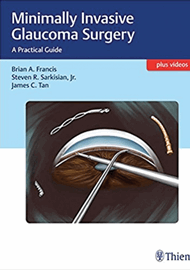The treatment of patients with mild to moderate glaucoma has evolved rapidly in the last decade. Traditionally, medical and laser treatments were the mainstay of therapy for this group of patients. Trabeculectomy, non-penetrating surgery and glaucoma drainage implants were reserved for patients with advanced glaucoma.
With an increasingly ageing population and better detection of glaucoma in the community, the glaucoma service needs of every eye unit has multiplied. The introduction of minimally invasive glaucoma surgery (MIGS) that offers a higher safety profile and quicker surgical rehabilitation has added to the options now available to this group of patients.
The book Minimally Invasive Glaucoma Surgery – A Practical Guide is a remarkable update for the ophthalmologist with a subspecialty interest in glaucoma to learn about newer surgical options available for glaucoma treatment. The book is divided into two sections and has an online video library of the surgical procedures.
Each section is further divided into four subsections on trabecular outflow, uveoscleral outflow, aqueous production and subconjunctival filtration.
The first section of the book addresses the anatomy and physiology of aqueous inflow and outflow and how a better understanding of each can be used to our advantage for IOP control. This is indeed an extraordinary feature of the book as it explains how the frequently overlooked basic sciences lay the foundation for technological advancements and innovations in a field.
The second section details the different MIGS procedures under the subheadings of trabecular outflow, uveoscleral outflow, aqueous production and subconjunctival filtration. Again each chapter starts with a case vignette that sets the scene for each of these laser / surgical options in current clinical practice. It then details the procedure, the rationale behind it, patient selection, results from current literature / recent clinical trials, postoperative management and complications. This consistently structured approach in all the chapters makes it an excellent resource for the reader. The last two chapters on combining MIGS procedures to target different mechanisms causing glaucoma and tips on incorporating MIGS into everyday clinical practice deserve a mention. The text is well illustrated and has high quality images supporting its content.
The online video library has 37 videos demonstrating several MIGS procedures discussed in the text. I felt that a simultaneous narration of the steps involved in each procedure by the authors, as well as standardisation of the quality of the video clip, would have further enhanced the presentation.
The 77 editors and contributors are world-renowned authorities on glaucoma and have shared their expertise on indications, techniques, outcomes and postoperative management of the novel MIGS procedures. The book is unique, comprehensive, relevent to current glaucoma clinical practice and is highly recommended. I hope readers will enjoy and appreciate the book as much as I did and it will serve as a good reference textbook for all glaucoma fellows and consultants.




